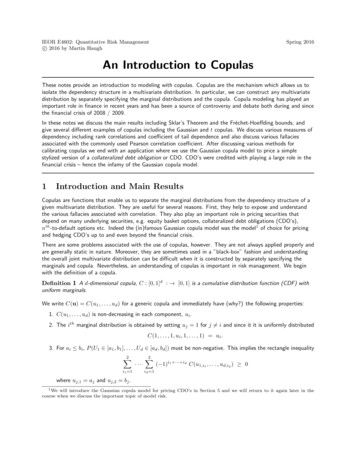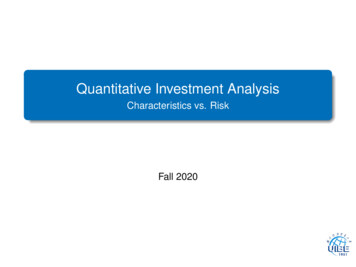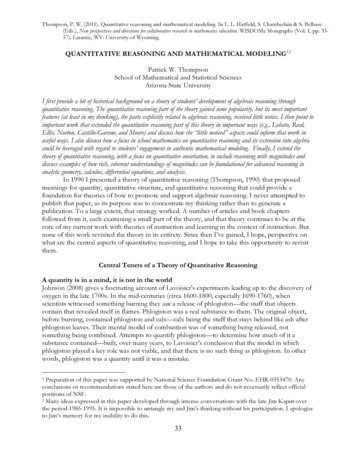
Transcription
IEOR E4602: Quantitative Risk Managementc 2016 by Martin HaughSpring 2016An Introduction to CopulasThese notes provide an introduction to modeling with copulas. Copulas are the mechanism which allows us toisolate the dependency structure in a multivariate distribution. In particular, we can construct any multivariatedistribution by separately specifying the marginal distributions and the copula. Copula modeling has played animportant role in finance in recent years and has been a source of controversy and debate both during and sincethe financial crisis of 2008 / 2009.In these notes we discuss the main results including Sklar’s Theorem and the Fréchet-Hoeffding bounds, andgive several different examples of copulas including the Gaussian and t copulas. We discuss various measures ofdependency including rank correlations and coefficient of tail dependence and also discuss various fallaciesassociated with the commonly used Pearson correlation coefficient. After discussing various methods forcalibrating copulas we end with an application where we use the Gaussian copula model to price a simplestylized version of a collateralized debt obligation or CDO. CDO’s were credited with playing a large role in thefinancial crisis – hence the infamy of the Gaussian copula model.1Introduction and Main ResultsCopulas are functions that enable us to separate the marginal distributions from the dependency structure of agiven multivariate distribution. They are useful for several reasons. First, they help to expose and understandthe various fallacies associated with correlation. They also play an important role in pricing securities thatdepend on many underlying securities, e.g. equity basket options, collateralized debt obligations (CDO’s),nth -to-default options etc. Indeed the (in)famous Gaussian copula model was the model1 of choice for pricingand hedging CDO’s up to and even beyond the financial crisis.There are some problems associated with the use of copulas, however. They are not always applied properly andare generally static in nature. Moreover, they are sometimes used in a ”black-box” fashion and understandingthe overall joint multivariate distribution can be difficult when it is constructed by separately specifying themarginals and copula. Nevertheless, an understanding of copulas is important in risk management. We beginwith the definition of a copula.Definition 1 A d-dimensional copula, C : [0, 1]d : [0, 1] is a cumulative distribution function (CDF) withuniform marginals.We write C(u) C(u1 , . . . , ud ) for a generic copula and immediately have (why?) the following properties:1. C(u1 , . . . , ud ) is non-decreasing in each component, ui .2. The ith marginal distribution is obtained by setting uj 1 for j 6 i and since it it is uniformly distributedC(1, . . . , 1, ui , 1, . . . , 1) ui .3. For ai bi , P (U1 [a1 , b1 ], . . . , Ud [ad , bd ]) must be non-negative. This implies the rectangle inequality2Xi1 1···2X( 1)i1 ··· id C(u1,i1 , . . . , ud,id ) 0id 1where uj,1 aj and uj,2 bj .1 Wewill introduce the Gaussian copula model for pricing CDO’s in Section 5 and we will return to it again later in thecourse when we discuss the important topic of model risk.
An Introduction to Copulas2The reverse is also true in that any function that satisfies properties 1 to 3 is a copula. It is also easy to confirmthat C(1, u1 , . . . , ud 1 ) is a (d 1)-dimensional copula and, more generally, that all k-dimensional marginalswith 2 k d are copulas. We now recall the definition of the quantile function or generalized inverse: for aCDF, F , the generalized inverse, F , is defined asF (x) : inf{v : F (v) x}.We then have the following well-known result:Proposition 1 If U U [0, 1] and FX is a CDF, thenP (F (U ) x) FX (x).In the opposite direction, if X has a continuous CDF, FX , thenFX (X) U [0, 1].Now let X (X1 , . . . , Xd ) be a multivariate random vector with CDF FX and with continuous and increasingmarginals. Then by Proposition 1 it follows that the joint distribution of FX1 (X1 ), . . . , FXd (Xd ) is a copula,CX say. We can find an expression for CX by noting thatCX (u1 , . . . , ud ) P (FX1 (X1 ) u1 , . . . , FXd (Xd ) ud ) 1 1 P X1 FX(u1 ), . . . , Xd FX(ud )1d 1 1 FX FX(u1 ), . . . , FX(ud ) .1d(1)If we now let uj : FXj (xj ) then (1) yieldsFX (x1 , . . . , xd ) CX (FX1 (x1 ), . . . , FXd (xd ))This is one side of the famous Sklar’s Theorem which we now state formally.Theorem 2 (Sklar’s Theorem 1959) Consider a d-dimensional CDF, F , with marginals F1 , . . . , Fd . Thenthere exists a copula, C, such thatF (x1 , . . . , xd ) C (F1 (x1 ), . . . , Fd (xd ))(2)for all xi [ , ] and i 1, . . . , d.If Fi is continuous for all i 1, . . . , d, then C is unique; otherwise C is uniquely determined only onRan(F1 ) · · · Ran(Fd ) where Ran(Fi ) denotes the range of the CDF, Fi .In the opposite direction, consider a copula, C, and univariate CDF’s, F1 , . . . , Fd . Then F as defined in (2) is amultivariate CDF with marginals F1 , . . . , Fd . Example 1 Let Y and Z be two IID random variables each with CDF, F (·). Let X1 : min(Y, Z) andX2 : max(Y, Z) with marginals F1 (·) and F2 (·), respectively. We then have2P (X1 x1 , X2 x2 ) 2 F (min{x1 , x2 }) F (x2 ) F (min{x1 , x2 }) .(3)We can derive (3) by considering separately the two cases (i) x2 x1 and (ii) x2 x1 .We would like to compute the copula, C(u1 , u2 ), of (X1 , X2 ). Towards this end we first note the two marginalssatisfy2F (x) F (x)2F1 (x) F2 (x) F (x)2 .But Sklar’s Theorem states that C(·, ·) satisfies C(F1 (x1 ), F2 (x2 )) F (x1 , x2 ) so if we connect the pieces(!)we will obtain C(u1 , u2 ) 2 min{1 1 u1 , u2 } u2 min{1 1 u1 , u2 }2 .
An Introduction to Copulas3When the Marginals Are ContinuousSuppose the marginal distributions, F1 , . . . , Fn , are continuous. It can then be shown thatFi (Fi (y)) y.(4)If we now evaluate (2) at xi Fi (ui ) and use (4) then we obtain the very useful characterizationC(u) F (F1 (u1 ), . . . , Fd (ud )).(5)The Density and Conditional Distribution of a CopulaIf the copula has a density, i.e. a PDF, then it is obtained in the usual manner asc(u) d C(u1 , . . . , ud ). u1 · · · udWhen d 2, we can plot c(u) to gain some intuition regarding the copula. We will see such plots later inSection 2. If the copula has a density and is given in the form of (5) then we can write f F1 1 (u1 ), . . . , Fd 1 (ud ) c(u) f1 F1 1 (u1 ) · · · fd Fd 1 (ud )where we have used Fi Fi 1 since Fi is differentiable. It is also easy to obtain the conditional distribution ofa copula. In particular, we haveP (U2 u2 U1 u1 ) limP (U2 u2 , U1 (u1 δ, u1 δ])P (U1 (u1 δ, u1 δ])limC(u1 δ, u2 ) C(u1 δ, u2 )2δδ 0δ 0 C(u1 , u2 ). u1This implies that the conditional CDF may be derived directly from the copula itself. The following result is oneof the most important in the theory of copulas. It essentially states that if we apply a monotonic transformationto each component in X (X1 , . . . , Xd ) then the copula of the resulting multivariate distribution remains thesame.Proposition 3 (Invariance Under Monotonic Transformations) Suppose the random variablesX1 , . . . , Xd have continuous marginals and copula, CX . Let Ti : R R, for i 1, . . . , d be strictly increasingfunctions. Then the dependence structure of the random variablesY1 : T1 (X1 ), . . . , Yd : Td (Xd )is also given by the copula CX . 1Sketch of proof when Tj ’s are continuous and FX’s exist:jFirst note thatFY (y1 , . . . , yd ) P (T1 (X1 ) y1 , . . . , Td (Xd ) yd ) P (X1 T1 1 (y1 ), . . . , Xd Td 1 (yd )) FX (T1 1 (y1 ), . . . , Td 1 (yd ))(6)so that (why?) FYj (yj ) FXj (Tj 1 (yj )). This in turn implies 1FY 1(yj ) Tj (FX(yj )).jj(7)
An Introduction to Copulas4The proof now follows becauseCY (u1 , . . . , ud ) FY FY 1(u1 ), . . . , FY 1(ud ) by (5)1d FX T1 1 FY 1(u1 ) , . . . , Td 1 FY 1(ud ) by (6)1d 1 1FX FX(u1 ), . . . , FX(ud ) by (7)1d CX (u1 , . . . , ud ) and so CX CY . The following important result was derived independently by Fréchet and Hoeffding.Theorem 4 (The Fréchet-Hoeffding Bounds) Consider a copula C(u) C(u1 , . . . , ud ). Then()dXmax 1 d ui , 0 C(u) min{u1 , . . . , ud }.i 1Sketch of Proof: The first inequality follows from the observation \C(u) P {Ui ui } 1 i d 1 P [{Ui ui } 1 i d 1 dXP (Ui ui ) 1 d i 1The second inequality follows sinceT1 i d {UidXui .i 1 ui } {Ui ui } for all i. The upper Fréchet-Hoeffding bound is tight for all d whereas the lower Fréchet-Hoeffding bound is tight onlywhen d 2. These bounds correspond to cases of extreme of dependency, i.e. comonotonicity andcountermonotonicity. The comonotonic copula is given byM (u) : min{u1 , . . . , ud }which is the Fréchet-Hoeffding upper bound. It corresponds to the case of extreme positive dependence. Wehave the following result.Proposition 5 Let X1 , . . . , Xd be random variables with continuous marginals and suppose Xi Ti (X1 ) fori 2, . . . , d where T2 , . . . , Td are strictly increasing transformations. Then X1 , . . . , Xd have the comonotoniccopula.Proof: Apply the invariance under monotonic transformations proposition and observe that the copula of(X1 , X1 , . . . , X1 ) is the comonotonic copula. The countermonotonic copula is the 2-dimensional copula that is the Fréchet-Hoeffding lower bound. ItsatisfiesW (u1 , u2 ) max{u1 u2 1, 0}(8)and corresponds to the case of perfect negative dependence.Exercise 1 Confirm that (8) is the joint distribution of (U, 1 U ) where U U (0, 1). Why is theFréchet-Hoeffding lower bound not a copula for d 2?
An Introduction to Copulas5The independence copula satisfiesΠ(u) dYuii 1and it is easy to confirm using Sklar’s Theorem that random variables are independent if and only if their copulais the independence copula.2The Gaussian, t and Other Parametric CopulasWe now discuss a number of other copulas, all of which are parametric. We begin with the very importantGaussian and t copulas.2.1The Gaussian CopulaRecall that when the marginal CDF’s are continuous we have from (5) that C(u) F (F1 (u1 ), . . . , F1 (ud )).Now let X MNd (0, P), where P is the correlation matrix of X. Then the corresponding Gaussian copula isdefined as CPGauss (u) : ΦP Φ 1 (u1 ), . . . , Φ 1 (ud )(9)where Φ(·) is the standard univariate normal CDF and ΦP (·) denotes the joint CDF of X.Exercise 2 Suppose Y MNd (µ, Σ) with Corr(Y) P. Explain why Y has the same copula as X. We cantherefore conclude that a Gaussian copula is fully specified by a correlation matrix, P.For d 2, we obtain the countermonotonic, independence and comonotonic copulas in (9) when ρ 1, 0,and 1, respectively. We can easily simulate the Gaussian copula via the following algorithm:Simulating the Gaussian Copula1. For an arbitrary covariance matrix, Σ, let P be its corresponding correlation matrix.2. Compute the Cholesky decomposition, A, of P so that P AT A.3. Generate Z MNd (0, Id ).4. Set X AT Z.5. Return U (Φ(X1 ), . . . , Φ(Xd )).The distribution of U is the Gaussian copula CPGauss (u) so thatProb(U1 u1 , . . . , Ud ud ) Φ Φ 1 (u1 ), . . . , Φ 1 (ud ) where u (u1 , . . . , ud ). This is also (why?) the copula of X.We can use this algorithm to generate any random vector Y (Y1 , . . . , Yd ) with arbitrary marginals andGaussian copula. To do this we first generate U using the above algorithm and then use the standard inversetransform method along each component to generate Yi Fi 1 (Ui ). That Y has the corresponding Gaussiancopula follows by our result on the invariance of copulas to monotonic transformations.
An Introduction to Copulas2.26The t CopulaRecall that X (X1 , . . . , Xd ) has a multivariate t distribution with ν degrees of freedom (d.o.f.) ifZX pξ/νwhere Z MNd (0, Σ) and ξ χ2ν independently of Z. The d-dimensional t-copula is then defined as t 1Cν,P(u) : tν,P t 1ν (u1 ), . . . , tν (ud )(10)where again P is a correlation matrix, tν,P is the joint CDF of X td (ν, 0, P) and tν is the standard univariateCDF of a t-distribution with ν d.o.f. As with the Gaussian copula, we can easily simulate from the t copula:Simulating the t Copula1. For an arbitrary covariance matrix, Σ, let P be its corresponding correlation matrix.2. Generate X MNd (0, P).3. Generate ξ χ2ν independent of X. pp4. Return U tν (X1 / ξ/ν), . . . , tν (Xd / ξ/ν) where tν is the CDF of a univariate t distribution with νdegrees-of-freedom.t(u), and this is also (why?) the copula of X. As before, we can useThe distribution of U is the t copula, Cν,Pthis algorithm to generate any random vector Y (Y1 , . . . , Yd ) with arbitrary marginals and a given tcopula.We first generate U with the t copula as described above and then use the standard inverse transformmethod along each component to generate Yi Fi 1 (Ui ).2.3Other Parametric CopulasThe bivariate Gumbel copula is defined as 1 CθGu (u1 , u2 ) : exp ( ln u1 )θ ( ln u2 )θ θ(11)where θ [1, ). When θ 1 in (11) we obtain the independence copula. When θ the Gumbel copulaconverges to the comonotonicity copula. The Gumbel copula is an example of a copula with tail dependence(see Section 3) in just one corner.Consider Figure 1 where we compare the bivariate normal and (bivariate) meta-Gumbel2 distributions. Inparticular, we obtained the two scatterplots by simulating 5, 000 points from each bivariate distribution. In eachcase the marginal distributions were standard normal. The linear correlation is .7 for both distributions but itshould be clear from the scatterplots that the meta-Gumbel is much more likely to see large joint moves. Wewill return to this issue of tail dependence in Section 3.In Figure 8.4 of Ruppert and Matteson (SDAFE 2015) we have plotted the bivariate Gumbel copula for variousvalues of θ. As such earlier, we see that tail dependence only occurs in one corner of the distribution.The bivariate Clayton copula is defined asCθCl (u1 , u2 ) : u θ u θ12 1 1/θ(12)where θ [ 1, )\{0}.2 The meta-Gumbel distribution is the name of any distribution that has a Gumbel copula. In this example the marginalsare standard normal. The “meta” terminology is generally used to denote the copula of a multivariate distribution, leaving themarginals to be otherwise specified.
An Introduction to Copulas7Figure 1: Bivariate Normal versus Bivariate Meta-Gumbel CopulaAs θ 0 in (12) we obtain the independence copula and as θ it can checked that the Clayton copulaconverges to the comonotonic copula. When θ 1 we obtain the Fréchet-Hoeffding lower bound. TheClayton copula therefore traces the countermonotonic, independence and comonotonic copulas as θ moves from 1 through 0 to . In Figure 8.3 of Ruppert and Matteson (SDAFE, 2015) we have plotted the bivariateClayton copula for various values of θ.The Clayton and Gumbel copulas belong to a more general family of copulas called the Archimedean copulas.They can be be generalized to d dimensions but their d-dimensional versions are exchangeable. This meansthat C(u1 , . . . , ud ) is unchanged if we permute u1 , . . . , ud implying that all pairs have the same dependencestructure. This has implications for modeling with Archimedean copulas!There are many other examples of parametric copulas. Some of these are discussed in MFE by McNeil, Frey andEmbrechts and SDAFE by Ruppert and Matteson.3Measures of DependenceUnderstanding the dependence structure of copulas is vital to understanding their properties. There are threeprincipal measures of dependence:1. The usual Pearson, i.e. linear, correlation coefficient is only defined if second moments exist. It isinvariant under positive linear transformations, but not under general strictly increasing transformations.Moreover, there are many fallacies associated with the Pearson correlation.2. Rank correlations only depend on the unique copula of the joint distribution and are therefore (why?)invariant to strictly increasing transformations. Rank correlations can also be very useful for calibratingcopulas to data. See Section 4.3.3. Coefficients of tail dependence are a measure of dependence in the extremes of the distributions.
θ 1.1θ 1.5θ 2 0.40.80.00.40.80.40.0u20.40.0u20.8 0.80.00.40.8u1θ 4θ 8θ 50 .40.80.0u28u20.40.0u20.8An Introduction to Copulas0.00.40.8u1Figure 8.4 from Ruppert and Matteson: Bivariate random samples of size 200 from various Gumbelcopulas.Fallacies of the Pearson Correlation CoefficientWe begin by discussing some of the most common fallacies associated with the Pearson correlation coefficient.In particular, each of the following statements is false!1. The marginal distributions and correlation matrix are enough to determine the joint distribution.2. For given univariate distributions, F1 and F2 , and any correlation value ρ [ 1, 1], it is always possible toconstruct a joint distribution F with margins F1 and F2 and correlation ρ.3. The VaR of the sum of two risks is largest when the two risks have maximal correlation.We have already provided (where?) a counter-example to the first statement earlier in these notes. We willfocus on the second statement / fallacy but first we recall the following definition.Definition 2 We say two random variables, X1 and X2 , are of the same type if there exist constants a 0and b R such thatX1 aX2 b.The following result addresses the second fallacy.Theorem 6 Let (X1 , X2 ) be a random vector with finite-variance marginal CDF’s F1 and F2 , respectively,and an unspecified joint CDF. Assuming Var(X1 ) 0 and Var(X2 ) 0, then the following statements hold:1. The attainable correlations form a closed interval [ρmin , ρmax ] with ρmin 0 ρmax .
An Introduction to Copulas9 0.00.40.00.40.8θ 0.3u20.80.40.0u20.80.80.00.40.8θ 0.1θ 0.1θ 1 θ 5θ 15θ 100 0.00.40.8u10.00.40.80.40.0u20.4 0.8u10.8u10.00.80.40.00.4θ 0.7u10.0u2 u20.40.0u20.80.0 u20.4 0.0u20.8θ 0.980.0u10.40.8u1Figure 8.3 from Ruppert and Matteson: Bivariate random samples of size 200 from various Claytoncopulas.2. The minimum correlation ρ ρmin is attained if and only if X1 and X2 are countermonotonic. Themaximum correlation ρ ρmax is attained if and only if X1 and X2 are comonotonic.3. ρmin 1 if and only if X1 and X2 are of the same type. ρmax 1 if and only if X1 and X2 are of thesame type.Proof: The proof is not very difficult; see MFE for details. 3.1Rank CorrelationsThere are two important rank correlation measures, namely Spearman’s rho and Kendall’s tau. We begin withthe former.Definition 3 For random variables X1 and X2 , Spearman’s rho is defined asρs (X1 , X2 ) : ρ(F1 (X1 ), F2 (X2 )).
An Introduction to Copulas10Spearman’s rho is therefore simply the linear correlation of the probability-transformed random variables. TheSpearman’s rho matrix is simply the matrix of pairwise Spearman’s rho correlations, ρ(Fi (Xi ), Fj (Xj )). It is(why?) a positive-definite matrix. If X1 and X2 have continuous marginals then it can be shown thatZ 1 Z 1(C(u1 , u2 ) u1 u2 ) du1 du2 .ρs (X1 , X2 ) 1200It is also possible to show that for a bivariate Gaussian copula6ρarcsin' ρπ2where ρ is the Pearson, i.e., linear, correlation coefficient.ρs (X1 , X2 ) Definition 4 For random variables X1 and X2 , Kendall’s tau is defined ash iρτ (X1 , X2 ) : E sign (X1 X̃1 ) (X2 X̃2 )where (X̃1 , X̃2 ) is independent of (X1 , X2 ) but has the same joint distribution as (X1 , X2 ).Note that Kendall’s tau can be written as ρτ (X1 , X2 ) P (X1 X̃1 ) (X2 X̃2 ) 0 P (X1 X̃1 ) (X2 X̃2 ) 0so if both probabilities are equal then ρτ (X1 , X2 ) 0. If X1 and X2 have continuous marginals then it can beshown thatZ Z11C(u1 , u2 ) dC(u1 , u2 ) 1.ρτ (X1 , X2 ) 400It may also be shown that for a bivariate Gaussian copula, or more generally, if X E2 (µ, P, ψ) andP (X µ) 0 then2arcsin ρ(13)ρτ (X1 , X2 ) πwhere ρ P12 P21 is the Pearson correlation coefficient. We note that (13) can be very useful for estimatingρ with fat-tailed elliptical distributions. It generally provides much more robust estimates of ρ than the usualPearson estimator. This can be seen from Figure 2 where we compare estimates of Pearson’s correlation usingthe usual Pearson estimator versus using Kendall’s τ and (13). The true underlying distribution was bivariate twith ν 3 degrees-of-freedom and true Pearson correlation ρ 0.5. Each point in Figure 2 was an estimateconstructed from a sample of n 60 (simulated) data-points from the true distribution. We see the estimatorbased on Kendall’s tau is clearly superior to the usual estimator.Exercise 3 Can you explain why Kendall’s tau performs so well here? Hint: It may be easier to figure out whythe usual Pearson estimator can sometimes perform so poorly.Properties of Spearman’s Rho and Kendall’s TauSpearman’s rho and Kendall’s tau are examples of rank correlations in that, when the marginals are continuous,they depend only on the bivariate copula and not on the marginals. They are therefore invariant in this caseunder strictly increasing transformations.Spearman’s rho and Kendall’s tau both take values in [ 1, 1]: They equal 0 for independent random variables. (It’s possible, however, for dependent variables to alsohave a rank correlation of 0.) They take the value 1 when X1 and X2 are comonotonic. They take the value 1 when X1 and X2 are countermonotonic.As discussed in Section 4.3, Spearman’s rho and Kendall’s tau can be very useful for calibrating copulas viamethod-of-moments type algorithms. And as we have seen, the second fallacy associated with the Pearsoncoefficient is clearly no longer an issue when we work with rank correlations.
An Introduction to Copulas11Pearson Correlation10.50 0.5 105001000150020000500100015002000Kendall’s Tau10.50 0.5 1Figure 2: Estimating Pearson’s correlation using the usual Pearson estimator versus using Kendall’s τ .Underlying distribution was bivariate t with ν 3 degrees-of-freedom and true Pearson correlation ρ 0.5.3.2Tail DependenceWe have the following definitions of lower and upper tail dependence.Definition 5 Let X1 and X2 denote two random variables with CDF’s F1 and F2 , respectively. Then thecoefficient of upper tail dependence, λu , is given byλu : lim P (X2 F2 (q) X1 F1 (q))q%1provided that the limit exists. Similarly, the coefficient of lower tail dependence, λl , is given byλl : lim P (X2 F2 (q) X1 F1 (q))q&0provided again that the limit exists.If λu 0, then we say that X1 and X2 have upper tail dependence while if λu 0 we say they areasymptotically independent in the upper tail. Lower tail dependence and asymptotically independent in the lowertail are similarly defined using λl . The upper and lower coefficients are identical for both the Gaussian and tcopulas. Unless ρ 1 it can be shown that the Gaussian copula is asymptotically independent in both tails.This is not true of the t copula, however. In Figure 8.6 of Ruppert and Matteson (SDAFE, 2015) we haveplotted λl λu as a function of ρ for various values of the d.o.f, ν. It is clear (and makes intuitive sense) thatλl λu is decreasing in ν for any fixed value of ρ.
121.0An Introduction to Copulas0.60.40.00.2λl λu0.8ν 1ν 4ν 25ν 250 1.0 0.50.00.51.0ρFigure 8.6 from Ruppert and Matteson: Coefficients of tail dependence for bivariate t-copulas asfunctions of ρ for ν 1, 4, 25 and 250.4Estimating CopulasThere are several related methods that can be used for estimating copulas:1. Maximum likelihood estimation (MLE). It is often considered too difficult to apply as there too manyparameters to estimate.2. Pseudo-MLE of which there are two types: parametric pseudo-MLE and semi-parametric pseudo-MLE.Pseudo-MLE seems to be used most often in practice. The marginals are estimated via their empiricalCDFs and the copula is then estimated via MLE.3. Moment-matching methods are also sometimes used. They methods can also be used for findingstarting points for (pseudo)-MLE.We now discuss these methods in further detail.4.1Maximum Likelihood EstimationLet Y (Y1 . . . Yd ) be a random vector and suppose we have parametric models FY1 (· θ 1 ), . . . , FYd (· θ d )for the marginal CDFs. We assume that we also have a parametric model cY (· θ C ) for the copula density of Y.By differentiating (2) we see that the density of Y is given byfY (y) fY (y1 , . . . , yd ) cY (FY1 (y1 ), . . . , FYd (yd ))dYj 1fYj (yj ).(14)
An Introduction to Copulas13Suppose now that we are given an IID sample Y1:n (Y1 , . . . , Yn ). We then obtain the log-likelihood aslog L(θ 1 , . . . , θ d , θ C ) lognYfY (yi )i 1 n Xlog[cY (FY1 (yi,1 θ 1 ), . . . , FYd (yi,d θ d ) θ C )]i 1 log (fY1 (yi,1 θ 1 )) · · · log (fYd (yi,d θ d )) .(15)b1 , . . . , θbd , θbC are obtained by maximizing (15) with respect to θ 1 , . . . , θ d , θ C . There areThe ML estimators θproblems with this approach, however:1. There are (tto) many parameters to estimate, especially for large values of d. As a result, performing theoptimization can be difficult.2. If any of the parametric univariate distributions FYi (· θ i ) are misspecified then this can cause biases inthe estimation of both the univariate distributions and the copula.4.2Pseudo-Maximum Likelihood EstimationThe pseudo-MLE approach helps to resolve the problems associated with the MLE approach mentioned above.It has two steps:1. First estimate the marginal CDFs to obtain FbYj for j 1, . . . , d. We can do this using either: The empirical CDF of y1,j , . . . , yn,j so thatPnFbYj (y) 1{yi,j y}.n 1i 1bj obtained using the usual univariate MLE approach. A parametric model with θ2. Then estimate the copula parameters θ C by maximizingnXh ilog cY FbY1 (yi,1 ), . . . , FbYd (yi,d ) θ C(16)i 1Note that (16) is obtained directly from (15) by only including terms that depend on the (as yet) unestimatedparameter vector θ C and setting the marginals at their fitted values obtained from Step 1. It is worthmentioning that even (16) may be difficult to maximize if d large. In that event it is important to have a goodstarting point for the optimization or to impose additional structure on θ C .4.3Fitting Gaussian and t CopulasA moment-matching approach for fitting either the Gaussian or t copulas can be obtained immediately from thefollowing result.Proposition 7 (Results 8.1 from Ruppert and Matteson)Let Y (Y1 . . . Yd ) have a meta-Gaussian distribution with continuous univariate marginal distributions andGausscopula CΩand let Ωi,j [Ω]i,j . Thenρτ (Yi , Yj ) 2arcsin (Ωi,j )π(17) 6arcsin (Ωi,j /2) Ωi,jπ(18)andρS (Yi , Yj )tIf instead Y
the overall joint multivariate distribution can be di cult when it is constructed by separately specifying the marginals and copula. Nevertheless, an understanding of copulas is important in risk management. We begin with the de nition of a copula. De nition 1 A d-dimensional copula, C: [0;1










